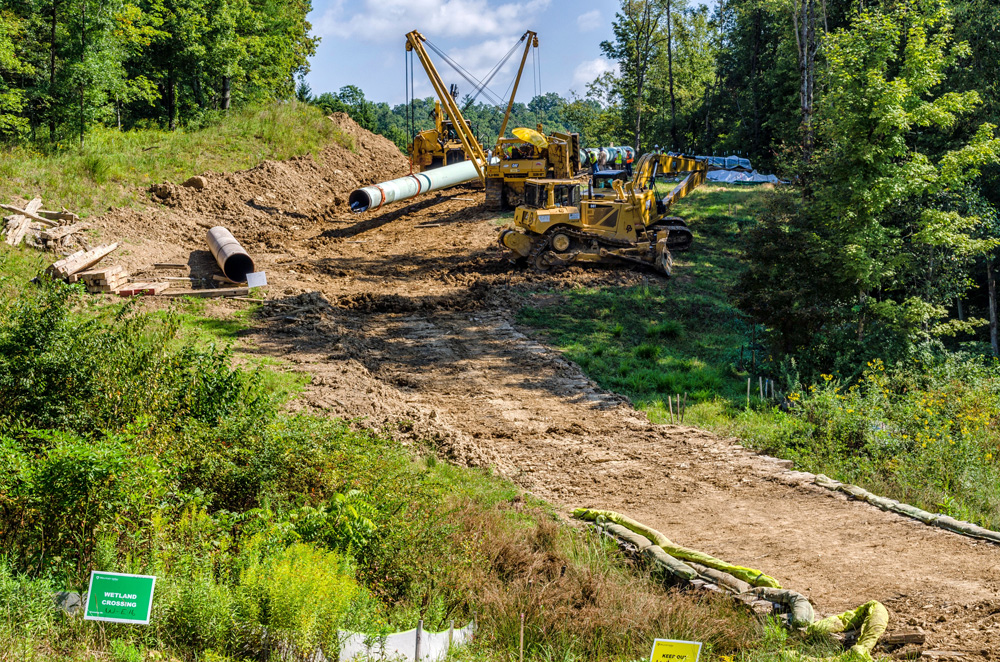May 2024, Vol. 251, No. 5
Features
Spotlight on Marcellus: Prolific Gas Play Keeps Rolling as Caution Persists
By Richard Nemec, Contributing Editor, North America
(P&GJ) – At the end of the first quarter of 2024, with natural gas prices depressed, the prolific Marcellus Shale gas play rolled along, albeit at a slower pace than usual with some producers cutting back production in March with a wait-and-see attitude toward prices.
Nevertheless, the nation’s largest gas producer, Pittsburgh, Pennsylvania-based EQT Corp. was busy signing a $5.5 billion re-merger with its former midstream unit, Equitrans MidStream Corp. With nearly 20 Tcf of proven gas reserves, when EQT signs on to this kind of transaction the nation’s natural gas bread basket pays attention.
In parsing out the deal leaving it with nearly a 75% ownership share of Equitrans, EQT pushed ahead in the midst of what Wall Street analysts were describing as a global gas glut plummeting commodity prices and forcing producers to curb output and spending on drilling activity. EQT, which has been described as an aggressive consolidator, curtailed nearly 1 Bcf/d of natural gas production in March, according to S&P Global Energy.
Newly combined, EQT/Equitrans becomes a vertically integrated natural gas business with an initial enterprise value of more than $35 billion. The expanded midstream footprint of EQT will encompass extensive overlap and direct connectivity in core operating areas, according to an analysis from Wood Mackenzie (WoodMac).
EQT gains operatorship and 49% ownership of one of the region’s most publicized pipelines – Mountain Valley Pipeline (MVP), in which EQT already holds 1.5 Bcf/d of firm capacity.
WoodMac said at the time that merger activity in U.S. shale oil and gas has “soared” in pursuit of greater scale and cost efficiencies amid volatile prices, with $250 billion in deals in the oil and gas industry in 2023. The combination will allow EQT to lower costs to produce and transport its gas to market by adding more than 2,000 miles of pipelines, the companies emphasized in announcing the deal.
After the announced combination, investors were skeptical of the company’s $13.4 billion in debt and $250 million a year in potential synergies. EQT shares initially dropped 8% ($34.53), while Equitran’s rose 2.7% ($11.55).
“We see greater value in Equitrans’ assets outside of MVP that might be divested to reduce debt,” said Eunji Oh, WoodMac senior analyst.
Operationally, the deal opens up the northeastern market more, according to Oh. Equitrans’ system is a well-connected set of pipelines in the Northeast, offering interconnections with seven interstate pipelines and numerous gathering systems and demand centers.
Another oil and gas analyst, Bertrand Donnes at Truist Securities, at the time expressed support for the combination “operationally,” but he noted that “the deal adds an equity overhang as midstream holders may have different priorities, and the incremental debt likely directs EQT’s free cash flow to leverage reduction over all other options for the near-term, which we expect to result in the shares trading down.”
EQT CEO Toby Rice and Equitrans senior officials emphasize various asset, operational and financial gains from the re-combination. As the nation’s largest vertically integrated gas company, EQT is better able to compete successfully on a global stage, they contend, citing 2,000 miles of pipeline infrastructure, a free cash flow break-even point below $2/MMBtu and better economics for maximizing profits from 4,000 drilling locations in the Marcellus.
“It [Equitrans] certainly is a benefit to EQT and gives them added strength,” said David Callahan, Marcellus Shale Coalition (MSC) president and a native Pennsylvanian. “We are fortunate in this basin to have some upstream companies that handle their own midstream work, and we also have a vibrant sector of midstream service providers for gathering lines and processing natural gas, or fractionization of natural gas liquids (NGL). This industry and its midstream part are very, very instrumental in the future growth to this basin.”
In 2023 and early this year, oil and gas analysts have been busy dissecting the mega-deals in the Permian Basin by Exxon Mobil Corp. and Chevron Corp., noting that the consolidation trend is carrying over into natural gas operators. For one, Tokyo Gas Co. Ltd. on Dec. 16, 2023, announced that its U.S. affiliate would buy private Haynesville Shale producer Rockcliff Energy LLC for $2.7 billion. Continued low commodity prices may help drive deals in 2024, according to Truist Securities’ Neal Dingmann, writing on Dec. 17, 2023.
“We continue to believe the recent move in the gas strip has caused a shakeup in any potential deals as privates feel a capital funding pinch, likely making some companies more attainable for the publics,” Dingmann concluded at that time.
In January, a shale gas megadeal was struck combining Appalachian and Haynesville Shale gas producers Chesapeake Energy Corp. and Southwestern Energy Co., with analysts’ predicting this will create an LNG giant based in the Haynesville with its proximity to the Gulf Coast.
For the shale plays, continued depressed prices are expected to lead to more cuts in producer capital budgets, according to RBAC Inc.’s senior director of market analysis, Bethel King, who in March told P&GJ that EQT, Chesapeake and others are expected to do this, along with what he called “slow-walking well completions, increasing drilled-but-uncompleted (DUC) wells, laying down fracking crews and perhaps focusing more on maintenance.
“Currently, the strategy appears to be one of ‘threading the needle’ until increased LNG exports come online and more favorable pricing actualizes,” he said.
What King calls “gas-centric producers” are faced with the challenge of figuring out the appropriate level of both capital spending and exploration/production (E&P) activity that will not drive gas prices even lower and still be able to ramp up production quickly when LNG-driven demand takes off.
“Furthermore, there are considerations related to cash flows, supply obligations, and natural production declines that need to be factored into the calculus as well,” King added.
The U.S. Energy Information Administration (EIA) in a short-term energy outlook in March predicted U.S. dry gas production in the Marcellus and elsewhere will “remain unchanged” at 104 Bcf/d with spot prices at Henry Hub to stay under $2/MMBtu.
“We expect lower gas prices to cause slight declines in production the remainder of 2024, and we do not expect that natural gas production will return to its December 2023 record of 106 Bcf/d during the forecast period,” EIA opined, estimating a 103 Bcf/d average for all of 2024, followed by increases to 104 Bcf/d the next year.
Eventual growth, EIA predicts, won’t necessarily come from shale gas plays. It sees the growth coming from increased associated gas production in the Permian and higher demand for U.S. LNG exports. The ongoing low prices last winter “were partially driven by reduced gas consumption in the residential and commercial sectors (November 2023 through March 2024),” according to EIA.
In a January research paper published in the American Association of Petroleum Geologists Bulletin by Wardama Saputra and three other co-authors, the Marcellus is described as “the largest mud-rock formation in North America” where the researchers apply what they called hybrid data-driven and physics-based methods to predict future gas production, dividing the 100,000-square-mile shale play into four regions, each with different reservoir qualities.
They then calculated various well completion rates in each region using four well cohorts in each region and apply “generalized extreme value statistics” to obtain historical well prototypes for average gas production region.
“[Finally], cumulative production from each well prototype is matched with a physics-based scaling model and extrapolated for two more decades [going forward],” they wrote in the AAPG Bulletin. “The resulting well prototypes are exceptionally robust. If we replace production rates from all of the wells in a given cohort with their corresponding well prototype, time shift the prototype well according to the date of first production from each well, and sum up the production, then this summation matches rather remarkably the historical gas field rate.”
On the regulatory side, potential concerns have been raised about EQT, the Appalachian region’s largest producer having control of a major midstream provider who serves other producers and competitors of EQT.
“In our view, the core value of this [recombination] is the integration of gathering and transmission assets across EQT’s Marcellus/Utica development areas,” said WoodMac’s analyst Oh. “Gathering and processing capacity fees can be substantial in a depressed price environment, and the acquisition could free up capital commitment for EQT and provide more operational flexibility for its upstream business in terms of production strategies.”
Cost reductions in a depressed commodity price market can have immediate positive impact to increase competitiveness of delivered supplies, Oh noted at the time of the transaction’s announcement.
Global and domestic leading supplies in the Marcellus continue to be strong, according to officials at the MSC coalition who spoke with P&GJ earlier this year. MSC includes most of the major producers, midstream operators, and service companies, operating in the world’s third largest natural gas production basin, the Appalachian Basin in parts of Pennsylvania, Ohio, and West Virginia.
“The base has certainly evolved and matured from its early days, but we’re still only scratching the surface,” said MSC’s Callahan, citing the fact that the U.S. Potential Gas Committee estimate for U.S. future supplies is well above 100 years’ worth of gas with the Marcellus/Utica being the largest source.
“[Thanks in part to the Appalachian dry gas bonanza,] the U.S. has been fortunate that with the shale revolution the nation has finally achieved energy security,” Callahan said. “For generations, U.S. presidents talked about it, and set goals, but now we have finally achieved that.”
In addition, we have sufficient supplies now to help our allies in Europe and elsewhere in the face of nations like Russia “weaponizing” energy exports against Europe, he notes.
The natural gas production in the Marcellus and Utica shales in the U.S. was 26.7 Bcf/d and 6.3 Bcf/d, respectively, at the start of the current decade. According to GlobalData, the natural gas production outlook in the Marcellus shale has been projected to maintain a stable growth trend through 2025.
The market also was projected to grow at a compound annual growth rate of more than 7% in the Marcellus and more than 16% in the Utica during the same period. On the other hand, crude oil production in the Utica shale is expected to stay almost flat.
Marcellus and Utica shale plays together represent are one of the largest and most highly concentrated U.S. natural gas resources. The plays are geologically placed in such a way that the Utica shale lies beneath the Marcellus shale in some states. Gas production in the Marcellus and Utica plays is carried out in the states of Pennsylvania, West Virginia and Ohio, with some in New York. The Marcellus and Utica plays have become one of the most progressive unconventional gas shales in the U.S.
Gathering and processing infrastructure is highly responsive to the market, but sufficient pipes need to be there when the production starts on the pad, advocates like Callahan stress.
“For transmission, we need more infrastructure – both intrastate and interstate. This includes a lot of new modernization and looping projects impacting interstate pipelines,” he said. “More capacity is needed here to reach all of the potential markets whether they are across the Atlantic Ocean or in New England and down the road here.”
Callahan is concerned about the lack of “regulatory clarity” as a principal cause for the lack of infrastructure. “It has been a never-ending challenge to get the necessary approvals in a timely fashion to build-out intra- and interstate capacity.”
He is looking for more timeliness and clearer signals so permits don’t continue to “bounce back” between regulators and project sponsors. “We can’t allow this to continue,” he said. “We need a clear path from wellhead to burner tip so we can get the needed permits to build the necessary infrastructure.”
Marcellus is already exporting NGLs around the world, according to Callahan, who also sees a real opportunity for the chemical sector of the U.S. economy to grow.
The American Chemistry Council (ACC) recently articulated a strong role for natural gas in advancing U.S. economic and climate change goals, viewing the fuel as essential for both the nation and the chemical industry. ACC CEO Chris Jahn calls gas critical to his industry providing fuel, power and feedstock through NGLs.
“Chemistry is positioned at the front end of the manufacturing supply chain, and virtually all manufactured goods are directly touched by the business of chemistry, Jahn noted in the forward to the ACC report on natural gas’ “key role” for the U.S. economy. The report supports the conclusion that gas is critical to a strong economy and clean environment.
On the environmental front, ACC maintains that the U.S. chemical industry “can play a leadership role in expanding the nation’s clean hydrogen economy – building on its deep process expertise; existing assets, sales, and distribution channels linked to hydrogen production; and access to opportunities to build new markets.”
The United States is one of the largest producers and consumers of hydrogen, accounting for around 12% of total global hydrogen production and use, the ACC report reiterates.
“Proper development and deployment of hydrogen technology can benefit the U.S. economy by enhancing U.S. manufacturing competitiveness, contributing to more resilient national and global supply chains, and creating high-quality American jobs,” ACC contends.
MSC’s Callahan points out that Pennsylvania also has two potential hydrogen hubs that he thinks are very attractive to a U.S. growing chemicals sector that is poised for more growth.
“Those hubs provide tremendous opportunities to explore the commercialization of hydrogen and carbon capture,” he said. “And already with just the increased use of natural gas in the United States since 2005, we have lowered carbon emissions by 44% in the power-generation sector nationally.”
Richard Nemec is a P&GJ contributing editor, based in Los Angeles. He can be reached at rnemec@ca.rr.com










Comments